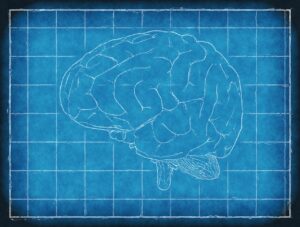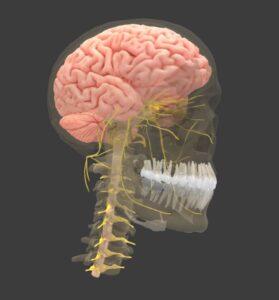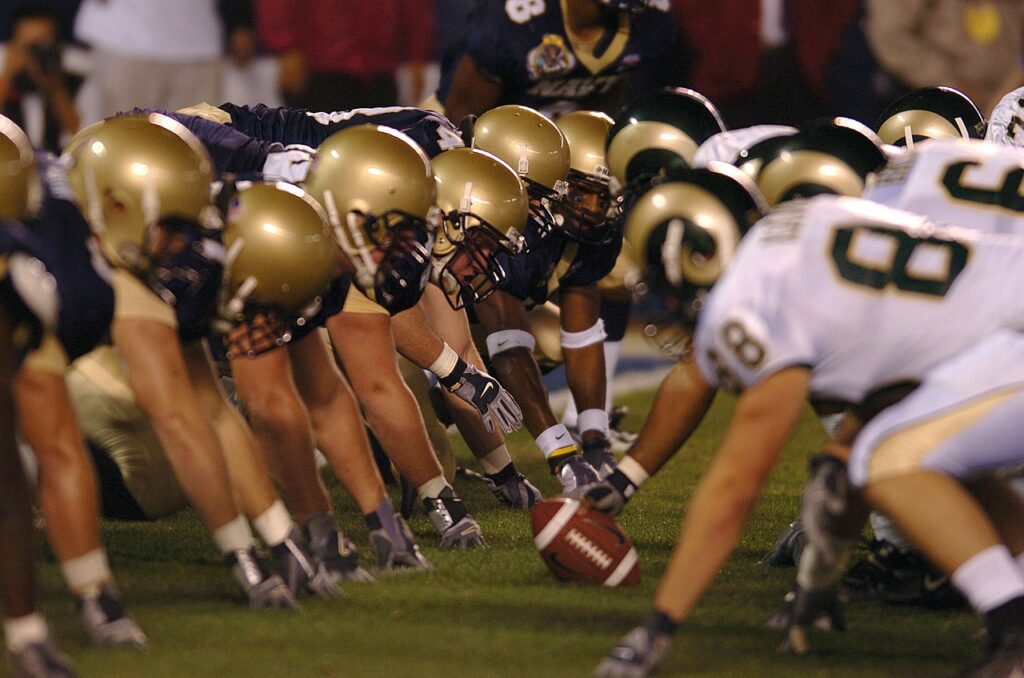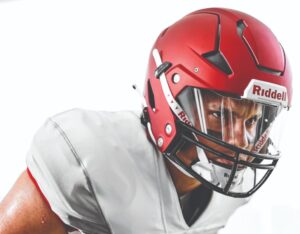A leading sports medicine doctor discusses the Biomechanics surrounding concussions in American Football. Truths will be upheld, myths exposed, and advice given that can lead to a brighter future for the sport.
*Disclaimer: this is for a school project and this piece is not actually coming from the perspective of a sports medicine doctor*
*Images not cited were free use images, courtesy of Pixabay*
January 29, 2022
THE BACKDROP
One player, a running back, side-steps a defender in the backfield and runs toward the two hole. SMACK! He is met by the hit of a linebacker. He falls backward to the ground with a thud. He gets right back up and heads back to the huddle for the next play. Another player on a different field, of similar size and stature, goes through the same process, but does not get right back up after the hit. As he lay on the grass, the medical staff rushes out and they end up bringing the player back to the sideline for evaluation. The diagnosis: concussion. Most have seen this on TV. Yet, the question must be asked: why did one player get a concussion while the other did not?

DEFINING TERMS
First, what exactly is a concussion? According to Dr. Khoi D. Than, an associate professor of neurosurgery and orthopaedic surgery at Duke University, it is “a clinical syndrome characterized by immediate and transient alteration in brain function, including alteration in mental status or level of consciousness, that results from mechanical force or trauma” (Agarwal, Thakkar, & Than, 2021). Furthermore, a concussion is a type of traumatic brain injury (TBI) that can result from the brain shaking quickly back and forth, causing it to bump into the skull. The word “concussion” actually stems from the Latin term “concutere,” meaning “to shake violently.” Resultingly, neurons can be damaged and bruising can take place on the brain (Nasrallah, 2018). In addition, blood vessel tearing and nerve fiber stretching can take place (Agarwal et al., 2021).
The symptoms of a concussion include the following: confusion, headache, altered vision, dizziness, nausea, ringing ears, and memory loss, among others. If such symptoms occur after a head impact, medical care should be sought (Agarwal et al., 2021). Microscopic damage can take place regarding brain cells that cannot be detected on a CT scan. As such, it is important to monitor for swelling even without a formal concussion diagnosis so as to avoid compression of the blood vessels in the brain, which can lead to a reduced flow of oxygen and glucose, which can lead to a stroke (Agarwal et al., 2021). General treatments include rest, analgesics (aspirin, ibuprofen, etc.) and avoiding screens until symptoms cease.
ANATOMY, PHYSIOLOGY, AND BEYOND
As can be seen, a lot is happening to the brain. Yet, what exactly is the brain? Essentially, it is your body’s control center. Digging in more, it is one of the most complex organs of the body that directs many processes, including thought, memory, emotion, touch, motor skills, vision, breathing, temperature regulation, hunger, and every process that contributes to homeostasis (Johns Hopkins, 2019). It is cushioned by cerebrospinal fluid that is deep to the skull. Generally, the brain can be divided into three sections: the cerebrum, the cerebellum, and the brainstem. More specifically, it can be divided into lobes. Such lobes include the frontal lobe, the parietal lobe, the temporal lobe, and the occipital lobe (Johns Hopkins, 2019). Each lobe oversees general tasks that your body performs. There are various cranial nerves that direct unique sensory and motor functions, deep structures (including the hypothalamus and pituitary gland) that synchronize, and meninges that cover the brain. Suffice it to say, it is imperative that this structure is protected so that our health can be sustained.
What is it made of? Overall, the brain is about 60% fat and weighs approximately three pounds (Johns Hopkins, 2019). It holds within it billions of neurons as well as many blood vessels. Furthermore, the white matter of the brain is composed of axons and the gray matter is composed of neuron cell bodies, which gives these regions their color differences (Johns Hopkins, 2019).
How does it work? Gray matter oversees information processing and interpretation while white matter relays that information to the rest of the nervous system (Johns Hopkins, 2019). The central nervous system (the brain and spinal cord) is in constant communication with the peripheral nervous system, via electrochemical signals, in order to sustain homeostasis. Any time you think, your brain is involved. Any time you eat, your brain is involved. Any time you sleep, your brain is involved. Any time you feel a sensation (pain, pressure, pleasure, etc.), your brain is involved. Any time you move, your brain is involved. It is like the quarterback of the body, receiving calls, relaying those calls, and doing what needs to be done to carry out the objective. The design truly is special; it is beyond our complete comprehension. Yet, one does not need to have a vast knowledge of the digestive system to know that eating an apple is going to be better than eating a cupcake.
This is the process that is being disrupted!

What about the skull and other surrounding structures? It is important to analyze such structures because any time the brain faces an impact, these are the structures that offer support. Well, let’s look at these structures more broadly first. The skull and cervical spine is composed of bone, and bone is composed of largely collagen, phosphorus, and calcium. These substances allow bones to remain strong, so players taking these in through their diets is crucial. The skull is actually 22 bones fused together (8 cranial and 14 facial) that serve to protect and provide a framework to carry out many functions, such as hearing, vision, tasting, and so on (Anderson, Kortz, & Al Kharazi, 2021). It also is involved in hematopoiesis (the production of blood and platelets). The neck includes the first 7 (C1-C7) vertebra of the vertebral column. The skull and vertebra are also involved in hematopoiesis (the production of blood and platelets), which occurs in the red marrow and serves to support the cardiovascular system.
There are also various muscles, tendons, and ligaments that are present in this region that will affect how force is absorbed. Muscles of the face allow for facial expression, vision, language, and chewing, which are all needed to talk about and play football in the first place (Anderson et al., 2021). Such muscles are activated by the cranial nerves discussed earlier. There are many passages in the skull that allow for such connections. It is important to understand the resiliency and overall function of such structures because their resiliency is affected by both their structure and function. For instance, when talking about the shoulder, the difference between the medial deltoid and the supraspinatus of the rotator cuff ought to be conceptualized because their activation and treatments of injury will be different. The supraspinatus is mostly working through the initial range of motion of a lateral raise while the medial deltoid is working more beyond the initial 20 degrees of so of abduction. This serves as a good visual for what can happen in other regions of the body, including the neck and facial musculature.
While the sternocleidomastoid (the big muscle you feel when you contract your neck) flexes the neck and rotates the head. On the other side of the coin, the splenius capitis extends the neck and is also involved in rotation. The splenius capitis is a deep muscle (beneath the trapezius) while the SCM is a superficial muscle. Football hits are almost always going to happen with the neck being forced into extension. Accordingly, the SCM will be lengthening, while both the splenius capitis and trapezius will be shortening. Any time muscle is involved, tendons are also involved. Ligaments will be nearby to support. Tendons and ligaments are composed mostly of water, collagen, and ground substance, with ligaments containing more elastin (McGinnis, 2020, p. 239). Many structures are affected not only by their collagen content, but by its arrangement. Tendons specifically have an easy ability to stretch. Yet, after a certain load, tendons can become very stiff (McGinnis, 2020, p. 240). Such functional characteristics affect the capabilities of the muscles. For instance, if the SCM tendon is partially- torn/strained, the SCM muscle that it attaches to the mastoid process will not be able to achieve a maximal contraction. There are many other smaller muscles involved here with their own tendons and ligaments, but this provides a general understanding of what is happening, particularly as it relates to American football. This will be discussed further in the topic of neck strengthening later on in this article.

Anatomy and
Physiology Revealed (2018). Head and neck anatomy [Screenshot].
McGraw-Hill Higher Education. https://anatomy.mheducation.com/html/apr.html?animal=human&mod=7641
MECHANISM OF INJURY
Considering the anatomy and physiology of the brain, what is the mechanism of such an injury as a concussion? In other words, how does such an injury occur? Well, there are four primary mechanisms that are possible with a concussion:
1. Direct Impact (the striking of the head by another object, even another head)
2. Sudden/rapid acceleration/deceleration (when there is no direct contact with the head)
3. Penetrating injury (from high-velocity projectiles, such as bullets)
4. Blast injury (from pressure propagated by an explosion)
For our purposes, we will be focusing on the first mechanism listed: direct impact.
Now that the matter of how the injury happens in general is discussed, another question must be examined: how do concussion events typically take place in American football? Concussions primarily happen in football due to the head striking/being struck by another object, whether it is the ground or another player’s head/helmet. More specifically, the change in translational velocity is higher for helmet-to-ground impacts when compared to helmet-to-helmet or helmet-to-shoulder impacts (Bailey et al., 2020). Some more specifics will be shared below (Lessley et al., 2018):
Most common event to cause concussion: tackling
Most common location to cause concussion: side of helmet
Most susceptible positions: cornerbacks and wide receivers
Most common play type where concussion occurs: passes
Most common frequency has to do with plays involving multiple impacts
INCIDENCE AND LAY DESCRIPTION
From 2015 to 2019, the number of concussions decreased by 23% regarding game settings. Before the 2018 season, new strategies were implemented in the NFL, which included rule changes and weighing the opinions of biomechanical experts on which helmets are best-performing (which banned 10 helmet models). With these new strategies, there was a two year decrease in the number of concussions (Mack et al., 2021). This indicates that such rules were successful. Taking this information, it can be inferred that if the same guidelines were followed across colleges, high schools, and colleges, there would be a decrease sum total from 2015 to 2019.
APPLYING BIOMECHANICAL PRINCIPLES
Working with my research team of biomechanists, we have connected the mechanism of injury and incidence to a few prominent biomechanical factors:
Torques: When it comes to torque, a couple of major implications can be discussed. Yet, what exactly is torque? Put simply, it is a turning movement propagated by force (McGinnis, 2020, p. 124). To conceptualize this, you can think of a game of table hockey. If you applied force right in the center of the puck, the puck would travel linearly away from you. Yet, if you hit the puck to the side, even slightly, the puck would travel rotationally away from the point you hit it; the more force, the more torque (McGinnis, 2020, p. 125). Here is one of the major implications: rotational motion/velocity has more of an impact on concussion occurrence than linear motion/velocity (Kleiven, 2013). Therefore, more torque can lead to more severe consequences on the field. Moreover, since increases in a moment arm increases torque, there is more risk for concussion when a head movement is made upwards toward another head. Torque (Nm) is equal to force (N) multiplied by the length (m) of the moment arm, so both must be examined (McGinnis, 2020, p. 127). Considering these implications, why is understanding torque important in this discussion? It is important because a reduction in the net effect of torque (through helmet engineering and other processes) can lead to less severe head impacts.
Friction: This can be described as the interaction between two surfaces sliding together, and the consequences thereof (McGinnis, 2020, p. 23). To conceptualize this, you can think about the impact of rubbing your hands together. If you rub your hands together very firmly, you will feel more resistance and more heat. On the contrary, if you rub your hands together very gently, there is less resistance and less heat. As such, with less friction comes less rotational motion with one object acting upon another, which can be tied into the discussion concerning torque above. Following suit, the more force that can be transferred to the orbit of the helmet and misdirected away from the skull, the better.
Strength: This can be thought of as the maximal force that can exerted by a person (McGinnis, 2020, p. 97). Since torque (in Newton-meters) is equal to force (in Newtons) multiplied by the length of the moment arm (in meters), strength will have a large impact here. The more strength, the more force; the more force, the larger the potential torque, which leads to more severe head impacts.
Considering all that has been talked about, in the story at the beginning, why did one player suffer a concussion and the other did not? As has been talked about, the difference is not necessarily the hit, but the ground. If one player had a weaker neck or at least a weaker response to contract their SCM and tuck their chin, this could explain the disparity. Beyond this, there are other factors to consider, such as the size of the moment from acceleration to hit, the strength of both players, and so on. While there may not be a clear answer, at least we now have a better idea of what could explain the difference in outcomes.

PAVING THE WAY FOR A BRIGHTER FUTURE
One method to help prevent concussions is strengthening the neck. While this may seem surprising, the support for this is sound. Think about it. If the neck is strengthened, neurological connections are stronger. When these connections are stronger, the muscles can be better controlled. From here, when a player is falling to the ground, they have a better chance of flexing their neck (their two scalene and sternocleidomastoid muscles). This helps to prevent the head from hitting the ground with more force (which causes more force to be equally and oppositely applied up into the player’s skull). Therefore, less force will be applied to the skull, and the brain will be better protected. In an EMG study that evaluated subject responses to applied forces and acoustic warnings, the following could be concluded (Homayounpour et al., 2021):
-Max pre-impact EMG value was greatest for startle response (38% maximum voluntary contraction)
-Directional anticipation can decrease reaction time
-Increased neck musculature activation correlated with reduced head linear and angular velocity
-Head injuries/TBIs can be reduced through neck muscle activation, but neck muscle injury is also increased through this.
Following suit, these applications can be made:
-An athlete being ready for an impact (being tense) has a better chance of avoiding a head injury.
-Neck strengthening and increased neuromuscular coordination can help reduce TBIs/concussions (specifically for the SCM, splenius, and hyoid muscles).
-Direct hits to the head should be avoided in sports.
Method 2: Equipment: Helmets
Another method to help prevent concussions is implementing new helmet technologies and properly fitting helmets. Since you don’t want the helmet to be too tight, which will lead to discomfort and increased friction (leads to more rotational motion of the head), or too loose (which could reduce overall protection and performance) what companies like Riddell are doing can make a huge impact on the game. With new helmet lines such as Speedflex Diamond and Axiom being introduced to the market, players can achieve a more precise fit all the way down to the high school level.
Moreover, with new helmet technology overall comes more protection, and less concussions. To support this claim, a study was conducted from 2005 to 2010 that investigated the effects of a new helmet design. The Riddell VSR4 and Riddell Revolution were compared. The results conveyed that there was a relative risk comparison of 46.1% when comparing the new helmet model to the older one (Rowson et al., 2014). This indicates that helmet technology has a statistically significant impact on concussion prevalence. Insite technology can also help coaches and football programs to keep track of head impact data, which will allow for more optimal practices and player techniques.

Riddell (2022). Riddell Axiom [Screenshot]. Riddell Newsroom. https://news.riddell.com/info/releases/riddell-launches-axiom-football-helmet-platform-designed-with-new-protection-and-performance-technologies
Method 3: Rule Changes and Protocol
Yet another method to help prevent concussions in the game of football involves rule changes and concussion protocols from youth leagues all the way to the NFL. From rule changes that happened in the NFL prior to the 2018 season, there was a noticeable decrease in concussions regarding the two years afterwards (Mack et al., 2021). The most prominent rule change concerned the lowering of the head to initiate contact; this now earns a 15-yard penalty. The types of helmets were also narrowed as well, which ties into the last point. Adding on to this, if a team athletic trainer, team physician, coach, or even teammate notices concussion symptoms in a payer, they are to be removed from the game and be examined on the sideline. This examination can include a video review, an evaluation of speech, and a gait review. A follow-up evaluation will also take place the next day. If an athlete is diagnosed with a concussion, they are to clear a five-phase return-to-play process. This ranges from supervised aerobic exercise to full activity clearance (symptoms must all be subsided). Such practices have trickled down to the youth level via organizations like USA Football.
Method 4: Rehabilitation
One last method that will be examined here as to do with rehabilitation; what can be done once a concussion has already occurred in order to prevent another one in a player? In order to reduce the chance for reoccurrence and reduce the chances of developing CTE (chronic traumatic encephalopathy – a degenerative condition brought about by repeated concussive events), a player can benefit from the practices cultivated by physical therapy. A 10 week study was conducted regarding patients who had prolonged concussion symptoms. Four of six patients involved in the study were able to return to their pre-concussion level of activity, with the other two patients returning to modified activities. The categories of improvement for all patients involved included symptom scores, gaze stability, balance and postural control measures, and symptom self-management. The methods used involved supervised aerobic and anaerobic exercise, stretching, manual therapy, balance work, and even gaze stability exercises (Hugentobler et al., 2015). This indicates that having an experienced medical professional integrating a treatment plan is an effective way for someone with a head injury (concussion) to restore their function and reduce negative symptoms. When function is restored and more bodily control is gained, there will most likely be less of a chance for someone to sustain a similar injury (Hugentobler et al., 2015).
PROFESSIONAL Insights
This discussion has involved a lot of material and has included a multitude of details. In light of this, here are some take-away points:
1. Understand the purpose.
2. Understand that there is risk involved with anything in life and there are always many factors to consider; no man is an island and no sport is either.
3. Concussions are serious injuries, but are usually not life-threatening.
4. Repeat concussions need to be avoided first and foremost for player safety, but also for player performance.
5. Concussion-symptom awareness should be upheld by teammates, coaches, and all athletic staff.
6. Head-to-head impacts should be reduced in terms of frequency and severity (through practice techniques, technology, rule changes, etc.) but the severity of head-to-ground impacts (which may be reduced through neck strengthening) should not be overlooked.
7. There is a declining trend in the number of relative concussions taking place in the sport of American football when using the NFL as the reference point. This is thanks to a wide range of factors, including training techniques, improved helmet technology, rule changes and protocol, and rehabilitation practices.
8. Understanding more about biomechanics can help us reduce injury and improve performance across a wide array of sports and activities.
THE HEART OF THE MATTER
References:
Agarwal, N., Thakkar, R., & Than, K. (2021). Concussion. American Association of Neurological Surgeons.
Anderson, B. W., Kortz, M.W., & Al Kharazi K.A. (2021). Anatomy, Head and Neck, Skull. NCBI.
Bailey, A. M., Sherwood, C. P., Funk, J. R., Crandall, J. R., Carter, N., Hessel, D., Beier, S., & Neale, W. (2020). Characterization of Concussive Events in Professional American Football Using Videogrammetry. Annals of biomedical engineering, 48(11), 2678–2690. https://doi.org/10.1007/s10439-020-02637-3CEMM.
CEMM. (2021). Mechanisms of TBI. Air Force Center of Excellence for Medical Multimedia.
Homayounpour, M., Gomez, N. G., Vasavada, A. N., & Merryweather, A. S. (2021). Cervical Muscle Activation Due to an Applied Force in Response to Different Types of Acoustic Warnings. Annals of biomedical engineering, 49(9), 2260–2272. https://doi.org/10.1007/s10439-021-02757-4
Hugentobler, J. A., Vegh, M., Janiszewski, B., & Quatman-Yates, C. (2015). PHYSICAL THERAPY INTERVENTION STRATEGIES FOR PATIENTS WITH PROLONGED MILD TRAUMATIC BRAIN INJURY SYMPTOMS: A CASE SERIES. International journal of sports physical therapy, 10(5), 676–689.
Johns Hopkins. (2019). Brain anatomy and how the brain works. Johns Hopkins.
Kleiven S. (2013). Why Most Traumatic Brain Injuries are Not Caused by Linear Acceleration but Skull Fractures are. Frontiers in bioengineering and biotechnology, 1, 15. https://doi.org/10.3389/fbioe.2013.00015
Lessley, D. J., Kent, R. W., Funk, J. R., Sherwood, C. P., Cormier, J. M., Crandall, J.
R., Arbogast, K. B., & Myers, B. S. (2018). Video Analysis of Reported
Concussion Events in the National Football League During the 2015-2016 and
2016-2017 Seasons. The American Journal of Sports Medicine, 46(14),
3502–3510. https://doi.org/10.1177/0363546518804498
Mack, C. D., Solomon, G., Covassin, T., Theodore, N., Cárdenas, J., & Sills, A.
(2021). Epidemiology of Concussion in the National Football League,
2015-2019. Sports Health, 13(5), 423–430. https://doi.org/10.1177/19417381211011446
Nasrallah, F. (2018). What does concussion do to the brain? Queensland
Brain Institute.
Rowson, S., Duma, S. M., Greenwald, R. M., Beckwith, J. G., Chu, J. J., Guskiewicz, K.
M., Mihalik, J. P., Crisco, J. J., Wilcox, B. J., McAllister, T. W.,
Maerlender, A. C., Broglio, S. P., Schnebel, B., Anderson, S., & Brolinson,
P. G. (2014). Can helmet design reduce the risk of concussion in
football?, Journal of Neurosurgery JNS, 120(4),
919-922. https://doi.org/10.3171/2014.1.JNS13916
